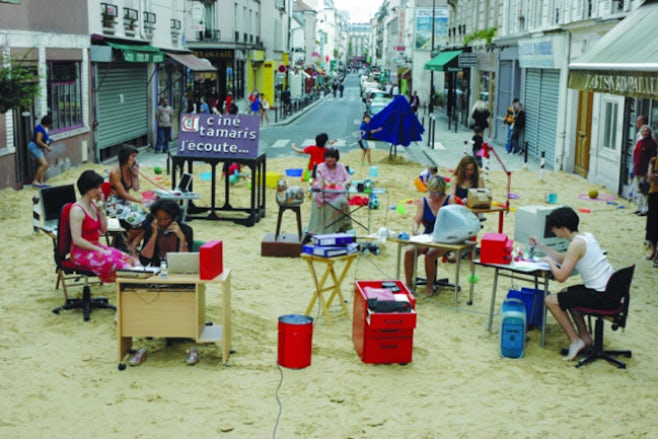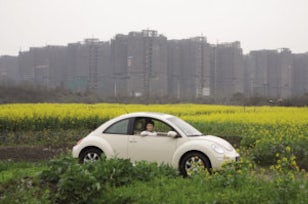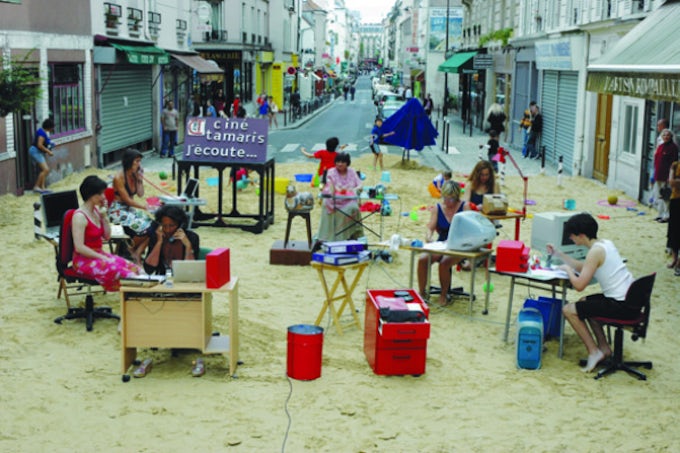
All of the films mentioned in this essay were seen at the 52nd London Film Festival. Under the artistic direction of Sandra Hebron, the festival showed over 200 films between 15-30 October 2008, the majority being British premieres of new films from around the world but also archival presentations by Cylde Jeavons and experimental work presented at the festival by Mark Webber.
1. Start with the body.
‘By chance, in 1980, I was struck by a scene in a TV documentary about republican prisoners in the H blocks… [a] film was shown of men “on the blanket”… It was a strange image of human dignity in the midst of self-created squalor and it was endowed with the mythic power most often associated with art. It manifested the noble spirit of Irish patriotism having retreated (or was it pushed?) into its own excreta.’
– Richard Hamilton 01
The much reported critical success of Steve McQueen’s Hunger (2008) accompanies the artist’s first move into feature-film production, working with a script written with Irish playwright Enda Walsh. A visceral and at times abstract exploration of the routines, ordeals and rituals endured by both the prisoners and the guards at the notorious H-Block prison in Belfast in 1980-81 is established in the film’s first half, before shifting to focus on Bobby Sands’s hunger strike and eventual death. Richard Hamilton famously depicted Sands and his excrement-smeared prison in his diptych The Citizen (1981-83), and the painter’s description seems to also be McQueen’s guiding motif: to create an ‘image of human dignity in the midst of self-created squalour’.
Drawing on an array of stylistic devices, the film depicts the political struggles in impressionistic detail from the excrement covered walls to the sound of riot police beating their truncheons against their shields. The open and fragmented first half is brought into focus in a long conversation between the Irish Republican Sands (played by Michael Fassbinder) and the Catholic Father Moran (played by Liam Cunningham), in which Sands reveals his intention to restart the hunger strike. Subsequently the film follows the slow disintegration of Sands’s body up until his death (the depiction of which is the only false note struck by the film). McQueen’s intense focus on the body largely excludes the broader context of the Troubles, with the exception of a few audio excepts of Margaret Thatcher, an external counter-attack (a murder) on one of the prison guards as well as final inter-titles explaining some of the ramifications of Sands’s actions, such as his election to MP for Fermanagh and South Tyrone during his strike. But unlike McQueen’s project For Queen and Country 02 (2002), a series of postage stamps commissioned by the Imperial War Museum bearing the faces of British soldiers killed in Iraq (which has been stalled in negotiations with the Royal Mail), Hunger was theatrically released in the UK on the 31st October 2008.
In contrast, in Michel Houellebecq’s feature length debut as director, The Possibility of an Island (2008), the natural body is depicted at the end of its natural evolutional potential and followed by an anaesthetised return through cloning in the film’s second half. Glacially shot, the film plays like a commercial (showing exquisite objects by German artist Rosemarie Trockel, which relate to an installation of a set from the film at the 2007 Lyon Biennial) or as a pastiche of Andrei Tarkovsky’s Solaris (1972). The studied vapidity of the film’s performances and aesthetic risks render the film as impotent as its cloned protagonist, and the open-ended conclusion, with Adam and Eve figures adrift in a new volcanic world plays as the credits roll, suggest that hope for mankind is a futile pursuit. Male impotence and vanity are the central focus for Night and Day/Bam gua nat (dir. Hang Sang-Soo, 2008) Korean director Hang Sang-Soo’s new film, which takes place within the Korean expatriate community in Paris. Organised as a diary the film chronicles day-to-day events in painter Sung-nam Kim’s (Yeong-ho Kim) paranoid self-imposed exile. Isolated in Paris he spends his time ingratiating himself with two female art students and fantasising about a potential affair. Supported by the Musee d’Orsay, the film is part of a current trend of French museums that have encouraged and actively funded international film production, in particular supporting directors from Southeast Asia — including Hou Hsiao-hsien and Tsai Ming-Liang in partnership with the Louvre. The d’Orsay is only featured in one scene, a moment of exquisite awkwardness in front of Gustave Courbet’s explicit L’Origine du monde (1866) that permeates the film.

The Argentine film Liverpool (2008) follows a solitary man returning to his family in the Tuerra del Fuego interior. This fourth film by Lisandro Alonso has been seen as the final part of a trilogy, together with his debut La Libertad (2001) and Los Muertos (2004), both films of little action, meticulous pacing and sound design, featuring men isolated or moving through a landscape. The exception, Fantasma (2006), is a meta-filmic companion to Los Muertos, relocating the earlier film’s non-professional protagonist from the jungle to the city for a solitary screening of his film — a comment on the rarefied but humble nature of Alonso’s filmmaking. Liverpool is structured around long, mainly dialogue-free (but far from silent) sequences, as the protagonist returns to his family and attempts to reconnect with his daughter.
The untimely death of the American experimental filmmaker Mark LaPore in 2005 inspired a surprising series of films by the experimental filmmaker Phil Solomon. Beginning with Untitled (For David Gatten) (2005), made with LaPore but completed after his death, the series is created with footage from the computer game series Grand Theft Auto. The game’s expansive environment, in which players’ avatars can roam freely, has been reengineered to create a shadow world in the short video Last Days in a Lonely Place (2008), through which the game’s avatar wanders, a digital dreamer somewhere between Caspar David Friedrich and the entranced figures of classic avant-garde cinema. Solomon, known for his technical proficiency with film processing (particularly for his collaborations with Stan Brakhage), focuses on the systematic abstractions inherent in the game’s 3D world, rendered in noir-ish black-and-white and in the hypnotic patterns of artificial rain fall. The video orchestrates a melancholy study of the fleeting nature of appearance — an immaterial treatise on the ambiguous comfort of images, surfaces and facades.
2.
The shifting ground.
‘Nature has ten million times the imagination of the most imaginative of artists.’
– Jean-Marie Straub 03
In Jia Zhangke’s latest film 24 City (2008), the state-owned factory in the Chinese city Chengdu becomes a microcosm of ‘the last half a century of Chinese history’ 04, while building on the director’s recent work integrating fictional characters into real and evolving landscapes, such as the Three Gorges Dam setting for Still Life (2006). Made during the redevelopment of Chengdu’s central factory complex into upscale apartments, the film chronicles the threat to the communities and histories contained in the building complex. Structured as a series of interviews with workers, the film also includes three staged interviews, whose fiction is signalled only by recognition of the actresses — Joan Cheng, playing Little Flower (also the name of her character in the early pro-Mao film Little Flower [dir. Zheng Zhang, 1980], which plays in the background of one scene), Lu Liping and Jia Zhangke’s regular leading lady, Zhao Toa. A continuation of Zhangke’s fiction films, as opposed to his documentary work, 24 City follows its director’s maxim that ‘history is always a blend of facts and imagination’. 05The rich, concealed history of Chengdu seems apt for Zhangke’s reflective handling of the truth; the city’s production of military equipment was kept an official secret and its southern location saw it utilised both for the first attack on Japan by the US army in World War II and as the Chinese National Party’s last bastion before their exile to Taiwan.
Fictional documentary was also explored in the short video Kempinski (2007), made in Mali by the French artist Neil Beloufa, and in which local residents consider their own hypothetical futures, invented for the film and related to the camera in the present tense. Reapplying Jean Rouch’s ethnographic strategies, the video confronts the viewer with its fictional futuristic present and the willing humour of its participants’ collaborations. Ah Liberty! (2008), a similar anti-epic film by British artist and filmmaker Ben Rivers, draws on the landscape of remote Scotland to depict the blasted romanticism of the Polcock family, through their mock-feral children, given an intimate grandeur through the film’s hand-processed 16mm CinemaScope images. Astika (2007), an earlier film by Rivers shown in a dedicated programme of his work, is a bittersweet study of the twilight years of a 1960s radical, now living as a recluse in Denmark. The film’s subject, Astika, recounts his life in fragments while depicted in his overgrown garden and dilapidated house. Expressing his desire to merge with the overgrown wildlife that surrounds him, his wish to return to nature is elevated to a nihilistic pitch.
Itineraire de Jean Bricard (2008), the last completed film by Jean-Marie Straub and the late Dani�le Huillet in their 40 years of collaboration, is a 40 minute rigorous exploration of land, history and change. The extraordinary opening sequence, a series of travelling shots filmed from a boat moving down the Loire river, is a vivid visual metaphor for the shifting nature and definition of land, history and nationality. What at first appears to be the river bank is revealed to be an independent island, land which is both part of and separate to its surroundings (the real ‘possibility of an island’). Based on a study of the region by Jean-Yves Petiteau and narrated via his interview with long-term resident Jean Bricard, the film investigates the shifting features of this border region between France and Germany, from its pivotal position in the French resistance to the changing nature of its agriculture industries and the effects of the re-channelling of the surrounding river. An invocation of a different sort permeates Straub’s first film made without Huillet since his short Machorka-Muff (1963). Here a mythological dialogue on the gap between the mortals and the gods taken from Italian poet and novelist Cesare Pavese’s ‘La Belva’ (‘The Wild Beast’), the sixth conversation in Pavese’s story collection Dialogues with Leuco (1947), is exchanged between two men in a forest clearing. Bearing the refinement of the pair’s previous work, the short film Le genou d’Artemide (2007), which was also screened, delights in the pleasures of direct sound and natural light, permeated by a longing drawn from Pavese’s text and the film’s own solitary production.
2. Return to the present
‘Beneath the paving stones — the beach!’
– Anonymous graffiti, Paris 1968
‘If you opened people up you would find landscapes.
If you opened me up you would find beaches.’
– Agnes Varda 06
Recent restorations have enabled the films of Guy Debord (1931-94) to be freshly considered, especially as they mark the first stages of legitimate distribution of English-subtitled versions of his films. Sur le passage de quelques personnes a travers une assez courte unite de temps (On the Passage of Few People Through a Rather Brief Unity of Time, Guy Debord, 1959), made in parallel to the emergentnouvelle vague, reflects the Situationist’s studied defiance of France’s bourgeois social values and the vacuity of mediatised society. Shifting between maps and tracking shots of the city, the film deconstructs documentary and fictional tropes � a sequence in a cafe, for example, is revealed and rejected as an impotent theatricality. Debord’s last film, IN GIRUM IMUS NOCTE ET CONSUMIMUR IGNI (1978), also screened as part of the festival’s Debord programme, was made after the disbanding of the Situationist International in 1972. At over 100 minutes the film collages and reorganises a huge amount of the material, ranging from advertisement and mainstream media to cannibalisation of Debord’s earlier films (including the Passage‘s cafe scene). Debord’s confrontational narrative starts with the assertion ‘I will make no concessions to the public in this film’, and concludes with a demand that spectators return to the beginning and start the film over again (referring to the famous palindromic title, often translated as ‘we spin around the night consumed by fire’). It is exactly this antagonist relationship — between control and authority — to be relished in Debord’s films; their exquisite negation of spectator pleasure is rarely matched.
Senegalese director Djibril Diop Mambety’s (1945-98) newly restored first feature Touki Bouki(1973) revolves around a young couple’s longing to relocate to Paris and the world Debord critiques. With its colours vividly reinstated, the film displays Mambety’s masterly compositions, biting satire and associative montage, displayed in a virtuoso lyrical sequence combining footage of a shamanic warning, the execution of a goat and a couple having sex on the African coast. Filled with parallel strands, the film combines the metaphorical and fantastical with a subversive depiction of Senegal’s embarrassed longing for the sophistication of the West.
In his new film, Japanese director Koji Wakamatsu returns to his radical youth to chronicle the fractious and tragic implosion of the militant left in the early 1970s Japan. In the first third of the three-hour-long United Red Army (2007), the development of the radical left is vividly established through news footage, photographs and restaged scenes detailing the escalation from student opposition to the renewal of the US-Japan Security Pact in the 1960s to the militant groups of the early 1970s. Wakamatsu is primarily known for bringing ‘Pink eiga’ films, an erotic genre previously exclusive to Japan, to Western attention with the scandalous competition screening of Secrets Behind the Wall (1965) at the Berlin Film Festival, much to the chagrin of the Japanese authorities. His sexually explicit and often politically charged work has seen him at odds with the government and he has been unable to attain a visa for the United States since his documentary Red Army / PFLP / Declaration of War (1971), shot in Palestinian camps in Jordan and Lebanon.
Wakamatsu’s new film, his most epic in scope and sober in execution (in contrast to the unrestrained sexual and political content of his previous films) seeks to re-examine this pivotal period in Japanese political history. Established in 1971 through the merger of two Japanese leftist groups, the (Japanese) Red Army Faction and the Japanese Red Army, the United Red Army withdrew to the mountain area of Gunma prefecture to pursue a training programme in preparation for ‘all-out war’. A perverse variation of Marxist self-criticism is forced without restraint on each member, eventually leading to the deaths of 12 members through torture and exhaustion. The film concludes with a recreation of the ‘Asama-Sanso incident’, where five members were massacred by police after a ten-day siege in February 1972. The film presents the contradictions inherent in the group factually while constantly noting the names and young age of new or deceased characters whose ideals gave way to increasingly desperate and violent actions. As Wakamatsu has stated, ‘Today most people just think they were stupid and wrong. For me it is more stupid to judge them so lightly. Have any problems been solved since then?’ 07

Les Plages d’Agnes/The Beaches of Agnes (Agnes Varda, 2008) is a kaleidoscopic autobiography eccentrically chronicling the diverse career of the director, her relationship with fellow filmmaker Jacques Demy and the changing nature of her work and life. After the interminable arrogance of Michel Auder’s three-hour compendium of his diaristic video work in The Feature (Michel Auder and Andrew Neel, 2007), exploring his life and love affairs with Viva and Cindy Sherman, the prospect of another older filmmaker recounting his or her life was an unappetising prospect. But Les Plages d’Agnes turned out to be one of the most moving and revelatory films of the festival, strikingly displaying Varda’s wit, modesty and seemingly effortless invention, the film is a brilliant reflection on old age and the shifting parameters of cinema and art. In returning and sometimes restaging sequences and encounters in her life and work, the film brings to the surface the full span of Varda’s enquiring and rigorous work. The sheer eclecticism of Varda’s output, which has seen her unfairly dismissed, is exactly where the richness and strength of her work lies, together with her ability to anticipate cultural shifts. Ranging from the pioneering parallel narratives in her feature debut La Pointe-courte (1956), celebrated by Alain Resnais and Chris Marker and foreshadowing their own application of the literary innovations of the nouvelle roman to her documentaries Saluts les Cubains(1963) and the Black Panthers (1968) to her brilliant application of the intimacy of digital technology in her last feature Les Glaneurs et la glaneuse (2000). Justifiably cherished by the art establishment (the film features her dressed as a large potato at the Venice Biennale) Varda’s body of work displays a richness and diversity matched by few filmmakers.
– George Clark
Footnotes
-
Hamilton is quoted in ‘How to Read a Modern Painting’, Jon Thompson, 18 May 2007, The Scotsman.
-
More information on the campaign organised by the Art Fund to have Queen and Country printed by the Royal Mail http://www.artfund.org/queenandcountry/index.php/
-
BFI 52nd London Film Festival Catalogue, London: BFI, 2008, p.23.
-
Ibid.
-
Ibid, p.76.
-
Ibid.
